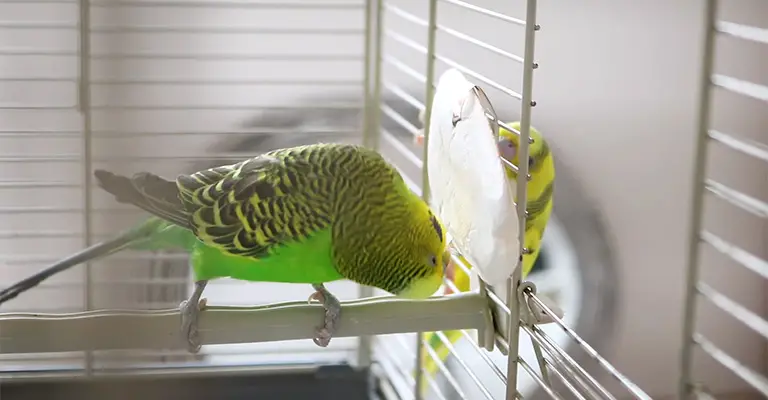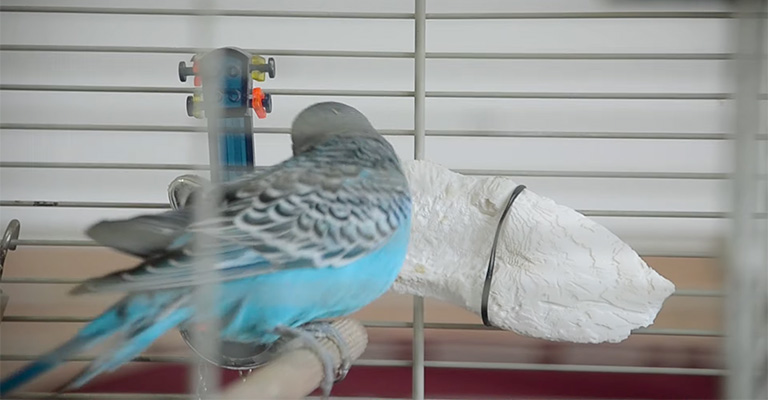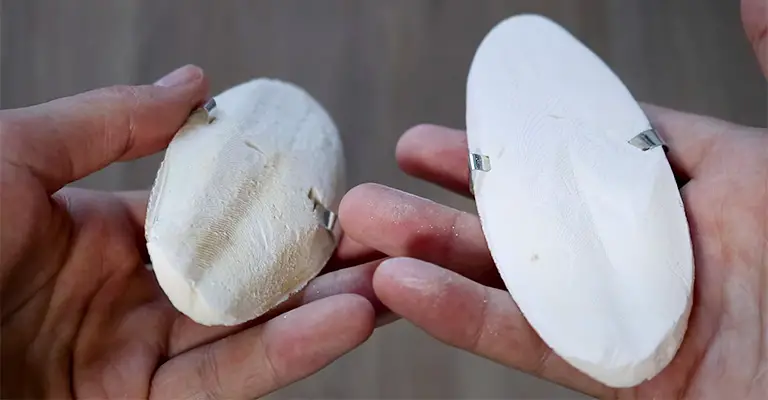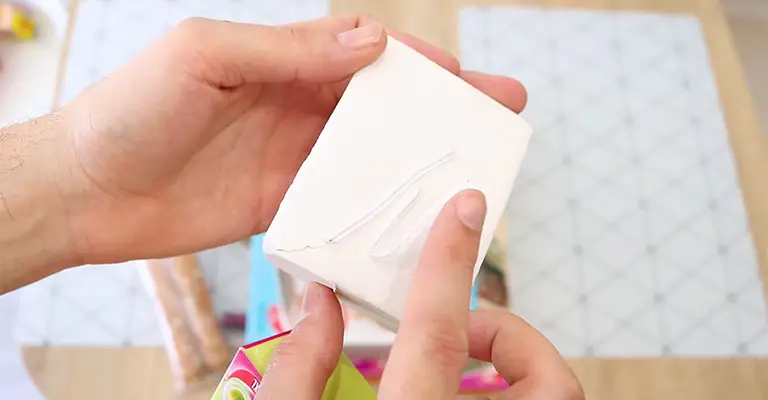Budgies, popularly known as parakeets, are cherished for their vibrant colors and playful nature. To maintain the health and happiness of these delightful avian companions, it’s essential to provide them with a well-rounded diet and proper care. But do budgies need mineral blocks?
Among the various aspects of budgie care, the presence of mineral blocks stands out as a crucial consideration. These blocks, formulated with essential minerals like calcium, iodine, and other trace elements, play a pivotal role in supporting the overall health of budgies.
In this article, we will delve into the reasons why mineral blocks are vital for budgies, exploring how they contribute to beak maintenance, bone health, and even mental stimulation.
By understanding the significance of these mineral-rich additions to their environment, you can ensure that your budgies enjoy a happy and fulfilling life.

Do Budgies Need Mineral Blocks?
Yes, budgies need mineral blocks for their optimal health and well-being. By providing these blocks, you’re taking proactive steps to ensure that your feathered companions receive the vital minerals they need.
From promoting strong bones to preventing behavioral issues, mineral blocks offer a multitude of benefits that contribute to the overall vitality and happiness of your beloved budgies. Here are the details:
Nutritional Balance and Mineral Deficiencies
Budgies, like all birds, require a balanced diet to thrive. Mineral blocks are an effective way to supplement their diet with essential minerals such as calcium, iodine, and more.
These minerals are crucial for proper bone development, eggshell formation, nerve function, and overall metabolic processes. Inadequate mineral intake can lead to various health issues and deficiencies.
Beak Maintenance and Physical Stimulation
Budgies’ beaks continuously grow, and they need appropriate means to keep them trimmed. Mineral blocks provide a natural and enjoyable way for budgies to gnaw and peck, helping to prevent overgrown beaks that can impede eating and grooming.
The act of interacting with mineral blocks also offers physical stimulation and helps prevent boredom, especially in captive birds.
Supporting Bone Health
Calcium is a fundamental mineral for budgies, aiding in the formation and maintenance of strong bones. Insufficient calcium intake can lead to brittle bones and disorders like egg binding in female budgies.
Mineral blocks offer a consistent source of calcium, particularly important during breeding or molting periods.
Preventing Behavioral Problems
Budgies are intelligent and active creatures. Inadequate mental stimulation can lead to behavioral problems like feather plucking or excessive vocalization.
Mineral blocks provide an engaging activity, helping to alleviate potential boredom and promoting mental well-being.
Convenient and Long-lasting Solution
Mineral blocks are a hassle-free way to ensure your budgies receive essential minerals. They are designed to last longer than traditional food sources, making them a cost-effective and time-saving option for maintaining your budgies’ health.
Choosing the Right Mineral Blocks

When selecting mineral blocks, opt for those specifically formulated for budgies or small parrots. Avoid blocks with added sugars or artificial colors, as these can be detrimental to their health.
Promoting Digestive Health
Mineral blocks often contain grit, which are small, hard particles that aid in the digestion of food. Budgies lack teeth and use grit to grind down seeds and other food items in their gizzard, enhancing the breakdown and absorption of nutrients.
Enhancing Feather Condition
Mineral blocks that contain essential trace minerals like zinc contribute to maintaining healthy feather quality. These minerals support the growth of vibrant and glossy plumage, enhancing the visual appeal of your budgies.
Social Interaction
Mineral blocks placed strategically within the cage can encourage social interaction among multiple budgies. They may gather around the block, engaging in playful interactions while pecking at it together, fostering a sense of camaraderie.
Providing a Focal Point
Budgies are naturally curious and love exploring their environment. A mineral block can serve as an intriguing focal point, attracting their attention and curiosity. This diversion can reduce stress and anxiety, especially in unfamiliar situations.
Preventing Obesity
Including mineral blocks in the cage can help prevent overconsumption of high-calorie treats or seed mixes. As budgies nibble on the block, it can decrease the likelihood of overeating, supporting weight management and overall health.
Addressing Mineral Imbalances
Certain minerals, such as iodine, play a crucial role in maintaining thyroid function and metabolic processes. Mineral blocks designed for budgies often contain iodine, which can help prevent thyroid-related issues.
Supporting egg-laying and Breeding
For budgies that are breeding or egg-laying, the extra calcium and minerals from mineral blocks can support the demanding requirements of this phase. It aids in producing strong eggshells and ensuring the health of both the parent birds and their offspring.
Educational Value
For budgie owners, observing their birds interact with mineral blocks can provide valuable insights into their behavior, preferences, and physical needs. This interactive experience can deepen the bond between you and your feathered companions.
Cuttlebone or Mineral Block for Budgies?

Both cuttlebones and mineral blocks offer distinct benefits for budgies, and the choice between them depends on your budgies’ specific needs and preferences:
Cuttlebone
- Calcium Source: Cuttlebones are primarily known for their calcium content, which is crucial for budgies’ bone health, especially during egg-laying and molting periods.
- Beak Maintenance: Budgies can gnaw on cuttlebones, helping to naturally trim their beaks and prevent overgrowth.
- Texture Variety: The texture of cuttlebone can provide a different tactile experience for budgies compared to their regular diet, promoting mental stimulation.
- Natural Source: Cuttlebones are natural and unprocessed, making them a relatively safe and traditional choice.
Mineral Block
- Diverse Nutrient Content: Mineral blocks are formulated to provide a range of essential minerals, not just calcium. They can address a broader spectrum of mineral deficiencies.
- Extended Use: Mineral blocks tend to last longer than cuttlebones, providing a consistent mineral source over a more extended period.
- Behavioral Stimulation: Budgies can peck and interact with mineral blocks, offering both physical and mental stimulation, which can help prevent boredom and associated behavioral issues.
- Variety of Formulations: Mineral blocks come in various formulations designed for budgies, offering specific mineral profiles that cater to their needs.
- Grit Inclusion: Some mineral blocks contain grit, aiding digestion and supporting overall gut health. In summary, both cuttlebones and mineral blocks have their merits. If your budgies need a calcium boost or beak maintenance, cuttlebones might be a suitable choice.
However, if you’re looking for a more comprehensive mineral supplementation along with behavioral enrichment, a mineral block could be a better option.
Some budgie owners even choose to offer both for a well-rounded approach to their budgies’ health and enjoyment.
How To Make Mineral Block for Budgies?

Creating a homemade mineral block for your budgies can be a fun and cost-effective way to ensure they get the essential nutrients they need. Here’s a basic recipe to get you started:
Ingredients
- Calcium Source: Crushed eggshells or powdered cuttlebone (for calcium).
- Mineral-rich foods: Finely ground mineral-rich foods like seeds, nuts, dried fruits, and vegetables.
- Honey or Gelatin Binder: Honey or unsweetened gelatin to bind the ingredients together.
Instructions
- Prepare the Ingredients: Crush and sterilize eggshells, or use powdered cuttlebone as a calcium source. Finely grind mineral-rich foods like seeds, nuts, dried fruits, and vegetables. Aim for a variety to provide a well-rounded mineral profile.
- Mixing: In a bowl, combine the crushed eggshells or powdered cuttlebone with the ground mineral-rich foods. Mix well to distribute the minerals evenly.
- Binding: Warm a small amount of honey or dissolve unsweetened gelatin in warm water according to package instructions. Gradually add the honey or gelatin to the dry mixture, stirring as you go. The mixture should come together to form a sticky consistency.
- Shaping: Press the mixture into small molds or shape it by hand into blocks or other desired shapes. You can use ice cube trays, silicone molds, or small plastic containers.
- Drying: Allow the blocks to dry and harden. This can be done at room temperature or by placing them in the refrigerator for a few hours.
- Offering to Budgies: Once the blocks are fully dried and solid, place them in your budgies’ cage. Ensure they are securely attached to a perch or the cage bars.
Important Tips
Use ingredients that are safe for budgies. Avoid toxic foods and be cautious with the amount of honey or gelatin you use.
Monitor your budgies’ interactions with the homemade mineral blocks to ensure they are eating and not just playing with them.
Homemade mineral blocks may not have the precise nutrient balance of commercial options, so they should be considered a supplement rather than a primary nutrient source.
FAQs
No, regular table salt is not suitable for budgies. It contains high levels of sodium which can be harmful to their health.
It’s important to provide mineral sources specifically formulated for budgies to ensure they receive the right balance of essential nutrients.
The frequency of replacement depends on how quickly your budgies consume the mineral block. Monitor the block’s size and condition – replace it when it’s significantly reduced in size or becomes soiled.
Yes, you can skip the honey or gelatin if you prefer. Instead, you can experiment with using a moistened seed mix or softened fruits/vegetables to bind the ingredients together.
The aim is to create a mixture that holds its shape without being too sticky or crumbly.
Avoid adding minerals like salt or any toxic substances. It’s best to focus on incorporating natural, budgie-safe ingredients like crushed eggshells, cuttlebone, ground seeds, nuts, and safe dried fruits and vegetables.
Yes, offering both options can provide a well-rounded approach to mineral supplementation.
Cuttlebones are an excellent source of calcium and offer beak-trimming benefits, while mineral blocks provide a broader range of essential minerals and behavioral enrichment.
Conclusion
Providing mineral blocks for your budgies goes beyond being just an optional accessory – it’s a proactive step toward ensuring their well-being and longevity.
These blocks offer a convenient and effective way to supplement your budgies’ diet with essential minerals.
From promoting strong bones and beak health to preventing mineral deficiencies, these blocks are a small investment that can yield significant rewards in terms of your budgies’ health.
Additionally, the physical and mental engagement that budgies experience while pecking at these blocks can contribute to their overall enrichment and happiness.
As responsible budgie owners, it’s our duty to create an environment that caters to their specific needs, and providing mineral blocks is undoubtedly an integral part of that commitment.
So, whether you’re a seasoned budgie enthusiast or a newcomer to avian companionship, make sure to include mineral blocks in your budgies’ habitat for a life that’s both vibrant and thriving.